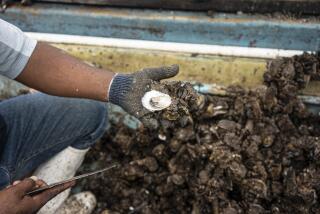Keep unwelcome norovirus stowaway from joining the cruise
- Share via
In January alone, five cruise-ship sailings experienced outbreaks of gastrointestinal illnesses linked to noroviruses, a group that causes acute bouts of vomiting and diarrhea. Symptoms generally subside in a day or two.
Outbreaks on ships get lots of attention, but the incidence of norovirus illnesses also is rising in other places and among the general population, says the Centers for Disease Control and Prevention, which reported recent outbreaks in nursing homes, schools and hotels.
Each year, the CDC says, about 23 million people in the United States -- 8% of the population -- contract noroviruses.
Among other ways, it can be transmitted by eating food or drinking liquids infected with the virus, touching infected surfaces or objects and then touching your face, or sharing food with an infected person.
“People shed this virus in their stool, and if they don’t properly wash their hands, any surface they touch they can contaminate,” says Dave Forney, chief of the CDC’s Vessel Sanitation Program, which is charged with overseeing cleanliness aboard cruise ships.
Once their hands are contaminated, people can infect themselves, he says, by eating finger foods or putting their hands in their mouths.
“There is a perception that it only happens on cruise ships,” and that’s incorrect, Forney says. Cruise lines must report all onboard cases of gastrointestinal illnesses to the CDC. “Doctors’ offices and hospitals don’t have to report this,” he says.
As a result, the cruise industry has become more focused on preventing outbreaks and containing them when they do occur, says Michael Crye, president of the International Council of Cruise Lines, an industry group. Likewise, hotels that have had outbreaks have stepped up their cleaning regimens.
Officials from the sanitation program inspect new cruise ships and conduct investigations to minimize the risk of norovirus-related diseases and other illnesses. The agency also posts ship scores on its website, www.cdc.gov/nceh/vsp.
If the number of ill passengers and crew reaches 1.5% or 2%, Forney says, “We almost always get a phone call from the company saying, ‘We are seeing such and such on this ship. Here is our itinerary.’ ” With 3% ill, the CDC declares an outbreak. An ongoing outbreak is one of several instances in which the CDC may step in and prevent a ship from sailing, Forney says.
In general, Crye says, a ship’s normal cleaning protocol is stepped up if there is an increase in reports of illness onboard. “You also limit passengers’ hand-to-hand contact.”
For instance, passengers might be asked to rub elbows with the ship captain at his reception rather than shake hands. The wait staff might serve passengers at a buffet instead of allowing them to serve themselves and having many hands touch serving utensils.
Travelers must do their part too. “So much of the responsibility lies with the patron,” says Rob Stillwell, a spokesman for the California Hotel in Las Vegas, which reported about 10 confirmed cases of norovirus-related illness last March. Since then, he says, the hotel has undertaken more stringent procedures, switching to hospital-grade cleaning solutions, and stocking moist disposable towelettes by the slot machines.
Healthy passengers who want to reduce their risk of getting sick should frequently wash their hands, using soap and water and scrubbing for at least 20 seconds, Forney says. “If people use an alcohol-based hand sanitizer, that should be used after you wash, not instead of.”
*
Healthy Traveler appears every other week. Kathleen Doheny can be reached at kathleen doheny@earthlink.net.
More to Read
Sign up for The Wild
We’ll help you find the best places to hike, bike and run, as well as the perfect silent spots for meditation and yoga.
You may occasionally receive promotional content from the Los Angeles Times.






